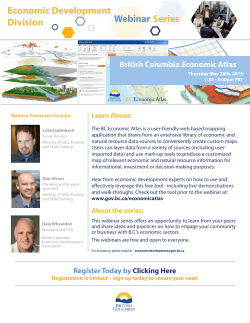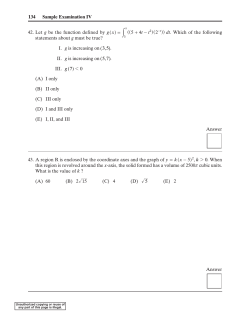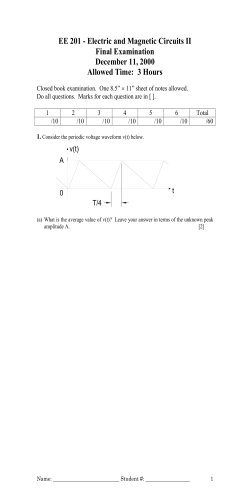
FET Sustainability Webinar â March 2015
Chapter NR 538, Wis. Adm. Code Beneficial Reuse of Industrial Byproduct March 27, 2015 FET Sustainability Webinar Ruth O’Donnell, WDNR NR 538 QUICK OVERVIEW Established January 1, 1998 Goal = encourage beneficial use of industrial byproducts in a nuisance‐free and environmentally sound manner http://www.we-energies.com/environmental/CoalCombustionProducts_2K11018.pdf Million cubic yards WISCONSIN INDUSTRIAL BYPRODUCTS 2000 – 2013 29.5 million yd3 available 19.6 million yd3 used NR 538.03(4) Specific high‐volume industrial byproducts: paper mill sludge, coal ash, flue gas desulfurization material, foundry sand & slag, lime kiln dust, Other non‐hazardous solid waste with similar characteristics Creates 5 categories of industrial byproducts Specific uses are allowed for each category Industrial Byproducts RCRA non‐hazardous Category (1‐5) assigned based on lab analysis ASTM Water Leach Test mg/L Total Elemental Analysis mg/kg Potential risk to human health & the environment Category 1 = few restrictions on use Category 5 = most restrictions on use & placement Category standards based on: NR 140 (drinking water) NR 105 (surface water quality) NR 720 (soil cleanup) Beneficial Uses Projects NR 538.10 Industrial Byproduct Category 5 4 3 2 1 x x x x x (1) (2) Raw Material for Manufacturing a Product Waste Stabilization / Solidification (3) Supplemental Fuel Source / Energy Recovery x x x x x x x x x x (4) Landfill Daily Cover / Internal Structures at landfills having a leachate collection system x x x x x (5) Confined Geotechnical Fill (a) commercial, industrial or institutional building subbase (b) paved lot base, subbase & subgrade fill (c ) paved roadway base, subbase & subgrade fill (d) utility trench backfill (e) bridge abutment backfill (f) tank, vault or tunnel abandonment (g) slabjacking material (h) soil and pavement base stabilization for structural improvements listed in (5)(a) - (c) (i) controlled low strength material (flowable) fill for structural improvements listed in (5)(a), (d), (e) and (f) (6) Encapsulated Transportation Facility Embankment (7) Capped Transportation Facility Embankment (8) Unconfined Geotechnical Fill (9) Unbonded Surface Course (10) Bonded Surface Course (11) Bonded Surface Course (Federal, state or municipal roadways) (12) Decorative Stone (13) Cold Weather Abrasive x x x x x x x x x x x x x x x x x x x x x x X x x NR 538, Appendix I Table 4 *Byproducts and uses need to meet structural and physical specifications and generally accepted engineering practices for the use. Obligated to meet all other Federal, State & Local permits, zoning and regulatory requirements that may apply. Regulatory Requirement Overview* Initial & annual reporting Industrial byproduct testing Storage & transportation requirements Project‐specific specifications Placement restrictions Public participation process for large projects Submittal of notification to DNR requesting project concurrence required with some projects Property owner notification Environmental monitoring – large volume DOT embankment projects * see code for all requirements Coal Combustion Residuals Bottom Ash – coarse to fine‐grain, sand‐like Structural fills, road bases and sub-bases, aggregate for concrete, asphalt and masonry, Fly Ash – fine powder, silt, cementitious SiO 2 +Al 2 O 3 +Fe 2 O 3 Concrete, structural fills, asphalt, soil stabilization Flue gas desulfurization gypsum ‐ CaSO 4 Agricultural soil amendment*, source of plant nutrients Ca & S, wallboard, cement manufacturing and concrete production *as allowed by NR 538.08(7) Foundry Byproducts Spent sand from mold process Geotechnical & structural fills, paved roadway base, sub-base, embankments Slag Cement manufacturing, aggregate replacement Category 2 Paper Mill Byproduct Pulping sludge used as raw material to make “soil”* *as allowed by NR 538.08(7) Used in mine reclamation, on landfills for fill purposes or to establish rooting zone for final grass cover NR 538.08(7) Case Specific • Allows the DNR to: 1) assign a category to a high volume solid waste not included in the definition of industrial byproduct Examples – Foundry baghouse dust containing high % of foundry sand from molding & unmolding process – Non‐ferrous foundry spent sand or slag NR 538.08(7) Case Specific OR 2) Conditionally approve a use not specified in rule at NR 538.10 for an industrial byproduct Examples – Beneficial use of material captured in flue gas desulfurization systems and paper mill sludge used for agricultural soil amendment Low‐Hazard Waste Exemption • What if…. – Material is not an industrial byproduct and – Proposed use is not specified in NR 538 • Then…. Investigate a low‐hazard exemption as allowed in sub. 289.43(8), Stats. DNR publication WA‐1645 Exempting Low‐Hazard Wastes from Solid Waste Regulations ch. NR 538.05 Solid waste rules exemption Persons who generate, use, transport or store industrial byproducts that are characterized and beneficially used are exempt from licensing under s. 289.31, Stats, and the regulatory requirements in chs. NR 500 to 538. HOWEVER If industrial byproducts are improperly handled and environmental problems result, the DNR will assess the cause and address the situation using administrative code and statutory authority BOTTOM LINE Generators are ultimately responsible for the management and disposition of all their industrial byproducts which are solid waste Know your process inputs and outputs If the process changes, new analysis is required to verify industrial byproduct category Work closely with contractor or entity utilizing the byproduct Resources • WDNR Beneficial Use of Industrial Byproducts – http://dnr.wi.gov/topic/Waste/Beneficial.html – http://prodoasext.dnr.wi.gov/inter1/pk_wm_doc_public$.startup (publications) • EPA Industrial Materials Recycling – http://www.epa.gov/osw/conserve/imr/index.htm • American Foundry Society – FIRST – http://www.afsinc.org/government/AFSFirst.cfm?ItemNumber=7887&navItemN umber=528 • American Coal Ash Association – http://www.acaa‐usa.org/ • Coal Combustion Product Utilization Handbook – http://www.we‐energies.com/environmental/recycle_coalash.htm Ruth O’Donnell [email protected] Building the Green Foundry Beneficial Reuse of Foundry Byproducts at Waupaca Foundry Bryant Esch, CHMM Environmental Coordinator Waupaca Foundry, Inc. FET Sustainability Webinar - Beneficial Reuse and Recycling, March 27, 2015 Metalcasting as a Sustainable Industry – Primary Recycling General Steel Scrap Compressed Pucks Tin Bales Cast FET Sustainability Webinar - Beneficial Reuse and Recycling, March 27, 2015 Waupaca Foundry’s 10-year Environmental Sustainability Vision • • • • Goals (2020): Reduce energy use intensity by 25%. Promote alternative processes and maintain state of the art pollution control technologies. Reduce spent foundry sand generation by 30% while promoting offsite reuse/recycling opportunities of the remaining spent foundry materials to achieve zero landfill disposal. Reduce water use consumption by 80%. FET Sustainability Webinar - Beneficial Reuse and Recycling, March 27, 2015 Beneficial Reuse Flowable Fill Gravel Pit Reclamation Embankment Fill Road Construction FET Sustainability Webinar - Beneficial Reuse and Recycling, March 27, 2015 Additional Foundry Byproduct Uses • Cement Production • Geotechnical Fill • Soil Amendments/Agriculture • Impermeable Layers (Manure Pits/Landfill Liners) FET Sustainability Webinar - Beneficial Reuse and Recycling, March 27, 2015 Transportation/Utility Projects FET Sustainability Webinar - Beneficial Reuse and Recycling, March 27, 2015 Foundry Sand Use in Transportation Projects (USH 10 Roadway Relocation) Wisconsin Department of Transportation - North Central Region • USH 10 Corridor, Portage County (2006) – Sand, slag, dust used as subbase fill to relocate USH 10 to the north over an adjacent historical sand mine – 160,000 tons FET Sustainability Webinar - Beneficial Reuse and Recycling, March 27, 2015 Commercial/Community Projects FET Sustainability Webinar - Beneficial Reuse and Recycling, March 27, 2015 Swan Park -Sledding Hill and Recreation Area SWAN PARK (2014) Waupaca, Wisconsin Project Description: Structural fill for a sledding/recreational hill, amphitheatre, parking lot expansion and construction of an ice skating rink. Project designed to the city of Waupaca’s engineer, parks and recreation department and mayor ‘s specifications. Project Scope: 275,000 tons of foundry sand and slag generated from the Waupaca Foundry of Waupaca, Wisconsin. The beneficial reuse material is being used to provide a park expansion in a previously unusable portion of the municipal park property. Project Benefit: $2,000,000 in avoided construction and materials costs and recovery of previously undevelopable city property. FET Sustainability Webinar - Beneficial Reuse and Recycling, March 27, 2015 Agriculture Projects FET Sustainability Webinar - Beneficial Reuse and Recycling, March 27, 2015 Farm Project-Barn Expansion EDGEWOOD DAIRY FARM PROJECT (2012) Custer, Wisconsin Project Description: Structural fill for foundation for barn expansion. Project Scope: 15,000 tons of foundry sand generated from the Waupaca Foundry of Waupaca, Wisconsin. Project Benefit: $50,000 in avoided construction and materials costs and expansion of farming operations. FET Sustainability Webinar - Beneficial Reuse and Recycling, March 27, 2015 Mine Reclamations FET Sustainability Webinar - Beneficial Reuse and Recycling, March 27, 2015 Foley Pit Mine Reclamation MINE RECLAMATION (2005) Waupaca, Wisconsin Project Description: Foundry sand was used as an unconfined geotechnical fill material in the reclamation of the Foley Sand/Gravel Pit. The foundry sand was placed at 3:1 horizontal to vertical slope and then covered with 18 inches of native soil and 6 inches of topsoil extending to the top of the pit sidewalls. Project Scope: 90,000 yd3 of foundry sand and slag generated from the Waupaca Foundry of Waupaca, Wisconsin. Project Benefit: The foundry sand proved to be a safe and costeffective fill material to achieve approximate original contours and facilitate the proper reclamation of a legacy mine site. FET Sustainability Webinar - Beneficial Reuse and Recycling, March 27, 2015 Before Foley Pit Mine Reclamation Waupaca County After FET Sustainability Webinar - Beneficial Reuse and Recycling, March 27, 2015 Foundry Sand as an Impermeable Construction Material • • • • Select foundry sand exceeds the environmental barrier requirements for landfill construction projects. Select foundry sands may contain up to 15 percent clay Can be used as a sustainable alternative to native clays in construction projects requiring impermeability barriers. Referenced in USDA-NRCS 313 guideline for manure pit construction sub-base fill. FET Sustainability Webinar - Beneficial Reuse and Recycling, March 27, 2015 Sand Reclamation Pneumatic/Mechanical Sand Reclaimer Thermal Sand Reclaimer Mechanical Thermal Mechanical FET Sustainability Webinar - Beneficial Reuse and Recycling, March 27, 2015 For additional information, please contact: • Bryant Esch • [email protected] • www.waupacafoundry.com FET Sustainability Webinar - Beneficial Reuse and Recycling, March 27, 2015 Recycle and Reuse Jon Raymond EHS Coordinator Kikkoman Foods, Inc 262-275-1617 Recycle and Reuse Jon Raymond Graduate of Carthage College -1986 Created my own Environmental Degree (Triple Major in Conservation, Geography and Natural Science) Seven Years with Environmental Monitoring and Technologies Environmental Consultant Fourteen Years with Sta-Rite Industries(Pentair) Environmental Engineer Currently over 8 years with Kikkoman Foods Inc Environmental Health and Safety Coordinator – In charge of Directing, Implementing and Maintaining EHS policies and programs Live in Edgerton, Wisconsin Wife Jennie – 2 Children 2 Corgis and 2 Cats A house divided Recycle and Reuse Cardboard Paper Glass Stretch wrap Plastic bottles Metal bottles Super sacks Plastic pails Paper ingredient bags Scrap metal Aerosol cans Bad pallets Construction debris Plastic barrels Used oil Oil absorbent pads Waste water Recycle and Reuse Reuse – no processing step – viable as is. Soy cake Soy oil Celite – diatomaceous earth CO Water Card board boxes Fiber glass tanks Recycle and Reuse Lessons Learned Make it easy Think outside of the box Always talk to the person next to you on an airplane WDNR can help – Conditional exemptions, Small business office, Green Tier Represent material as waste – end user determines acceptable for application Thank you! Watch for information on the next FET Sustainability Webinar For more information on the FET Sustainability Committee, contact: Rebecca Vanderbeck ‐ [email protected]
© Copyright 2025









